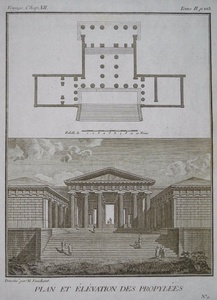| Method | Copper engraving |
| Artist | Henri-Joseph Godin after Jacques Foucherot |
| Published | Dessiné par M. Foucherot [c.1788] |
| Dimensions | Image 212 x 166 mm, Plate 252 x 190 mm, Sheet 262 x 204 mm |
| Notes |
A floorplan of the Propylaea in Athens, the grand entrance way to the temples of the Athenian acropolis, Plate 9 from the 1788 edition of Barbie du Bocage's Recueil de Cartes Geographiques Plans, Vues, et Medailles de l'Ancienne Grece, Reelatifs au Voyage du Jeune Anacharsis. In addition to the floorplan, the plate also includes a topographical view of the Propylaea. The view was probably taken from the neighbouring Areopagus, as it does not show the lower sections of the acropolis walls and the monumental podiums of the first gate. The structure is shown as it would have been during the late fifth century BC, when the city of Athens was at its apogee. The Propylaea was constructed during the 430s BC as part of the Periclean rebuilding of the Acropolis after the destruction of the pre-existing monuments by the Persians. The architect, Mnesicles, had originally planned another two wings to the building on the eastern side, but these were never built, owing to the increasing demands on Athens' resources brought about by the outbreak of the Peloponnesian War. In the Medieval period, the building was used by the aristocratic Acciaioli family as a palace. During the Ottoman period, the Propylaea, like the neighbouring Parthenon, was used as an armaments store. It was severely damaged in the seventeenth century when a powder magazine exploded, a fate similar to that which the Parthenon would suffer in 1687 during a siege carried out by the Venetians. The Recueil de Cartes Geographiques Plans, Vues, et Medailles de l'Ancienne Grece, Reelatifs au Voyage du Jeune Anacharsis was an atlas published by the Paris booksellers, printmakers, and engravers Jean Denis Barbie du Bocage to accompany Jean-Jacques Barthelemy's Voyage du jeune Anacharsis en Grèce dans le milieu du IVe siècle. The Voyage du jeune Anacharsis was an unusual work. Written as a sort of general guidebook to the cities, customs, and culture of classical Greece, it purported to be the work of the grandson of the Scythian philosopher Anacharsis, documenting his travels in Greece during the 4th century BC. This clever literary conceit allowed the real author, Barthelemy, to explore the history and society of Classical Greece in a manner that was informative, yet informal, aiming to appeal to a much broader audience than a traditional academic history. Barthelemy was a talented antiquarian, particularly in regards to the study of ancient numismatics, and although the content of his work contains numerous historical flaws, the Voyage du jeune Anacharsis was a huge success, appearing in numerous editions and reprints. Sadly Barthelemy received very little from his success, his aristocratic background marking him as a target for the Revolutionary government, who confiscated most of his wealth. Despite his economic hardships, the general public continued to hold him in high esteem, and the demand for his material on ancient Greece was the main motivation behind the publication in 1788 of the accompanying Atlas to the Voyage. The first edition of Barbie's Recueil contained 31 plates related to Barthelemy's text, including maps of cities and territories, plans of battles, religious sanctuaries, and public spaces, and illustrations of temples, theatres, and even coins. Henri-Joseph Godin (1747-1834) was a French painter, engraver, and printmaker. He worked on maps for a number of atlases, as well as portraits, architectural plans, and antiquarian subjects. Jacques Foucherot (5th February 1746 - 16th September 1813) was a French architect, draughtsman, and archaeologist. A fellow of the French Royal Academy of Architecture, in 1776 he accompanied the Comte de Choiseul-Gouffier on a Grand Tour to the Ottoman Empire, being the first Frenchman to survey a number of the classical ruins of the Greek Islands and the Turkish Coast of the Aegean, among them Naxos, Santorini, Patmos, Telmessos, Halicarnassus, and Bodrum. In 1780, he travelled to Ottoman Greece with the Comte's friend and assistant, the artist and diplomat Louis-François-Sébastien Fauvel. Their journey was extensive, and well documented by Foucherot, who carried out extensive surveys of monuments they deemed important historically or particularly impressive architecturally. The pair are reputedly the first modern archaeologists to have carried out surveys in the Bronze Age sites of Mycenae, Tiryns, and Argos, as well as the classical remains of Nemea. Although they were not given permission to visit the ruins of Delphi, they were permitted in Athens to visit the buildings of the Acropolis, and did much to improve upon earlier drawings of the Parthenon, Erechtheum, and Propylaea. Following his return from Greece, Foucherot reworked a number of his site plans and surveys for publication in Barbie du Bocage's Recueil de Cartes Geographiques Plans, Vues, et Medailles de l'Ancienne Grece, Reelatifs au Voyage du Jeune Anacharsis. Condition: Trimmed to platemark on left margin. To small tears to left margin, not affecting image. |
| Framing | unmounted |
| Price | £40.00 |
| Stock ID | 13276 |

